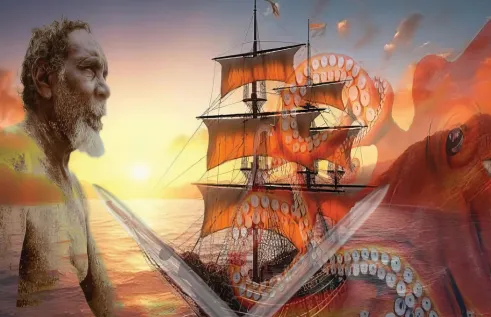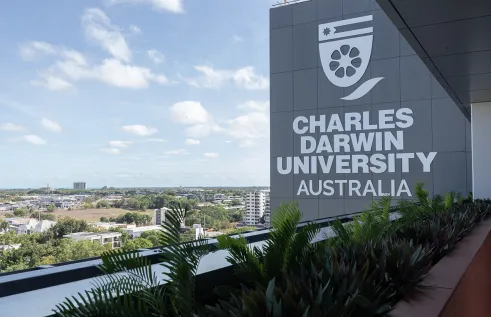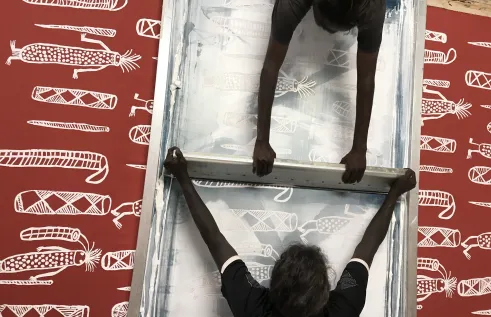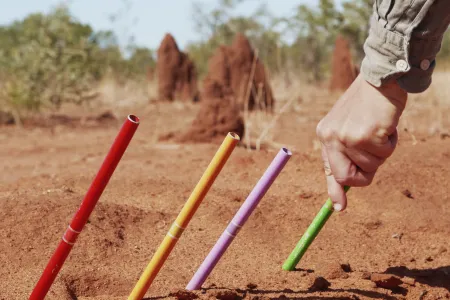Art, science and First Nations knowledge combine in Where Lakes Once Had Water symposium
The artists behind an immersive video investigating 130,000 years of changes in climate, landscape and ecology in the Northern Territory will discuss their artwork at a public symposium held at Charles Darwin University (CDU) Art Gallery on May 17.
Where Lakes Once Had Water (2020) by Sonia Leber and David Chesworth is an audio-visual artwork focusing on a team of Earth and environmental scientists from the ARC Centre of Excellence for Australian Biodiversity and Heritage (CABAH) who, alongside Indigenous rangers, Elders and community members, are investigating changes in the climate, landscape and ecology.
The artwork was filmed in 2018 and 2019 on the lands and waters of the Mudburra, Marlinja, Jingili, Elliot, Jawoyn and Larrakia communities, with additional filming and editing on Barkandji, Dharawal, Djabugay, Yidinji and Wurundjeri Country.
Where Lakes Once Had Water is showing at CDU Art Gallery until July 15.
The artwork focuses on a team of Earth and environmental scientists from the ARC Centre of Excellence for Australian Biodiversity and Heritage (CABAH) who, alongside Indigenous rangers, Elders and community members, are investigating changes in the climate, landscape and ecology.
Leber and Chesworth will discuss the video alongside Larrakia ranger and artist Roque Lee, and palaeoecologists Dr Cassandra Rowe and Mick Brand from CABAH whose research was captured by the artwork. CDU Digital Humanities Professor Jennifer Deger will chair the symposium.
The two-screen, 4K UHD video installation examines how the Earth is experienced and understood through different ways of being, seeing, sensing, listening and thinking, and how these reverberate across art, Indigenous thought, science, ancient and modern cultures and non-humans.
The video was filmed in a variety of long-term dry landscapes in the Northern Territory including Lake Woods (near Elliott), Nitmiluk and Girraween Lagoon, 50 kilometres south of Darwin.
“We travelled south of Darwin, observing everyone working together across the ancient lakes and shorelines, receptive to the signs, signals and rhythms of the land,” the artists said.
“All the while the fieldwork was observed by non-human cohabitants, as ecologies of birds, termites and flies continued their struggles for survival.”
CDU Art Gallery Curator, Dr Joanna Barrkman said the gallery was pleased to be able to present the work to the public.
“The opportunity to explore the intersect between First Nations knowledge, science and art, through the medium of video, helps us consider the role artists can play in extending the reach of scientific research and the communication of new and ancient knowledges,” Dr Barrkman said.
The symposium is from 3pm to 5pm.
Leber and Chesworth will give a talk on the making of Where Lakes Once Had Water at 5.15pm, followed by a screening of the artwork.
Where Lakes Once Had Water is on display at the CDU Art Gallery until July 15.
Where Lakes Once Had Water was commissioned by the Australian Research Council Centre of Excellence for Australian Biodiversity and Heritage (CABAH) in association with Bundanon. It is the first commission of the CABAH Art Series, initiated in 2018 to engage artists with aspects of CABAH’s research to make new work that responds to, questions, and interprets the research for broader audiences. The work is on loan from the University of Wollongong Art Collection.
Partners on the project are Charles Darwin University, the Australian Research Council Centre of Excellence for Australian Biodiversity and Heritage, the Australian Research Council, the University of Wollongong, Bundanon and the Gordon Darling Foundation.
Related Articles

New exhibitions bring First Nations perspectives and collaborative artistry to the forefront
A vision to capture and share sacred values, knowledge and connections through modern technology will come to life in two new exhibitions at Charles Darwin University Art Gallery this week.
Read more about New exhibitions bring First Nations perspectives and collaborative artistry to the forefront
CDU rises in 2026 QS World University Rankings, bucking national trend
Charles Darwin University (CDU) has climbed to 584 in the prestigious 2026 QS World University Rankings - a marked improvement from its position in the 621-630 band last year - defying the national trend.
Read more about CDU rises in 2026 QS World University Rankings, bucking national trend
Bábbarra Women’s Centre printed textiles grace CDU Art Gallery
Charles Darwin University’s (CDU) Art Gallery will be teeming with bold and colourful hand-printed textiles this month, with the launch of new exhibition Manburrba: our story of printed cloth from Bábbarra Women’s Centre.
Read more about Bábbarra Women’s Centre printed textiles grace CDU Art Gallery
